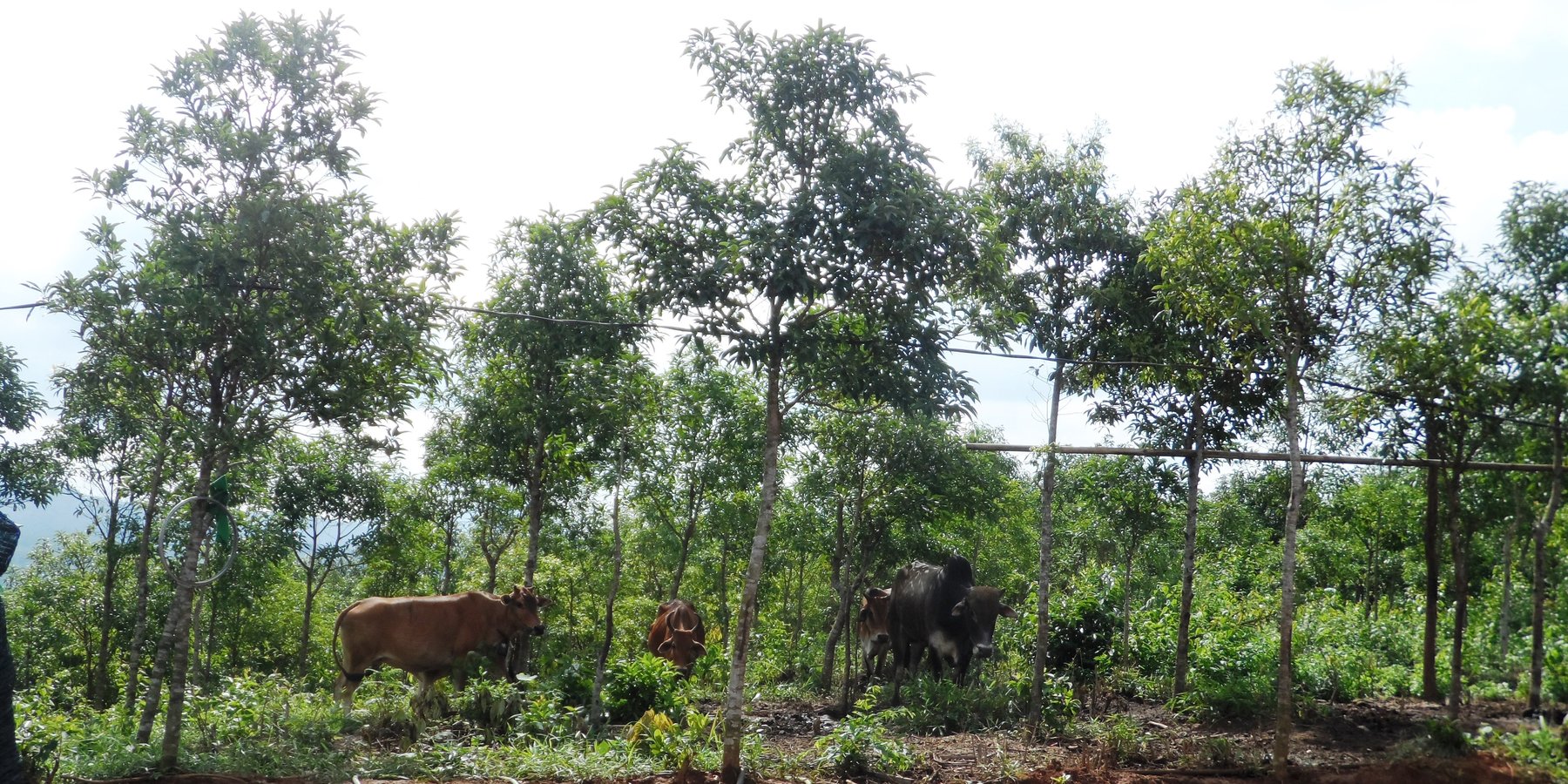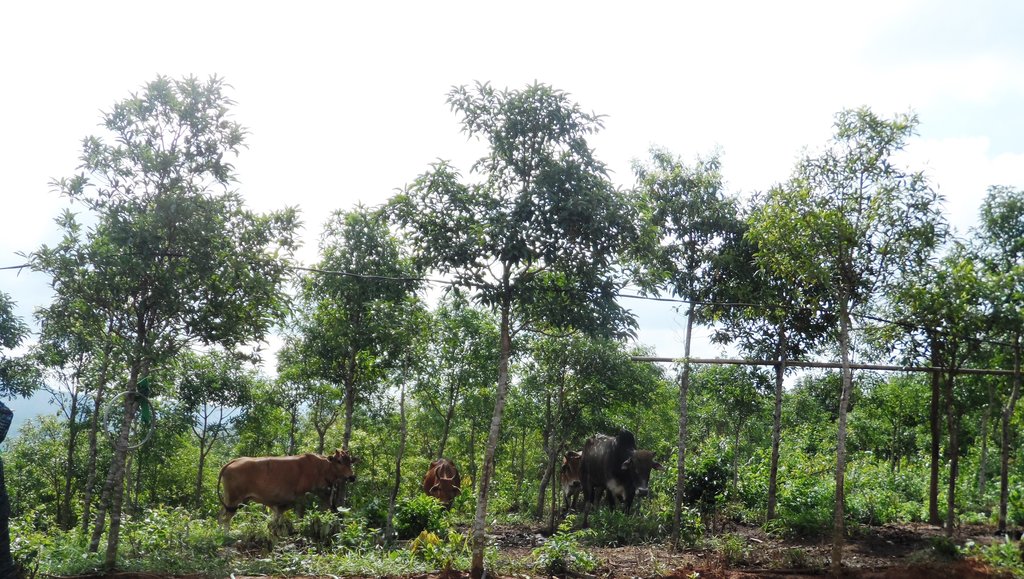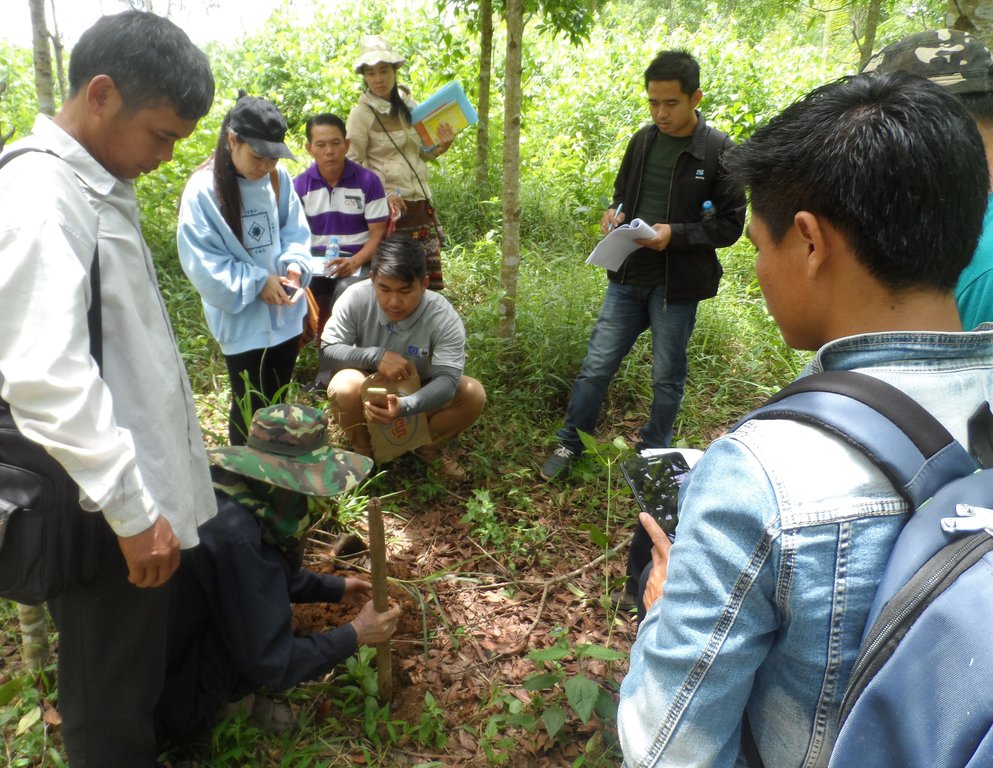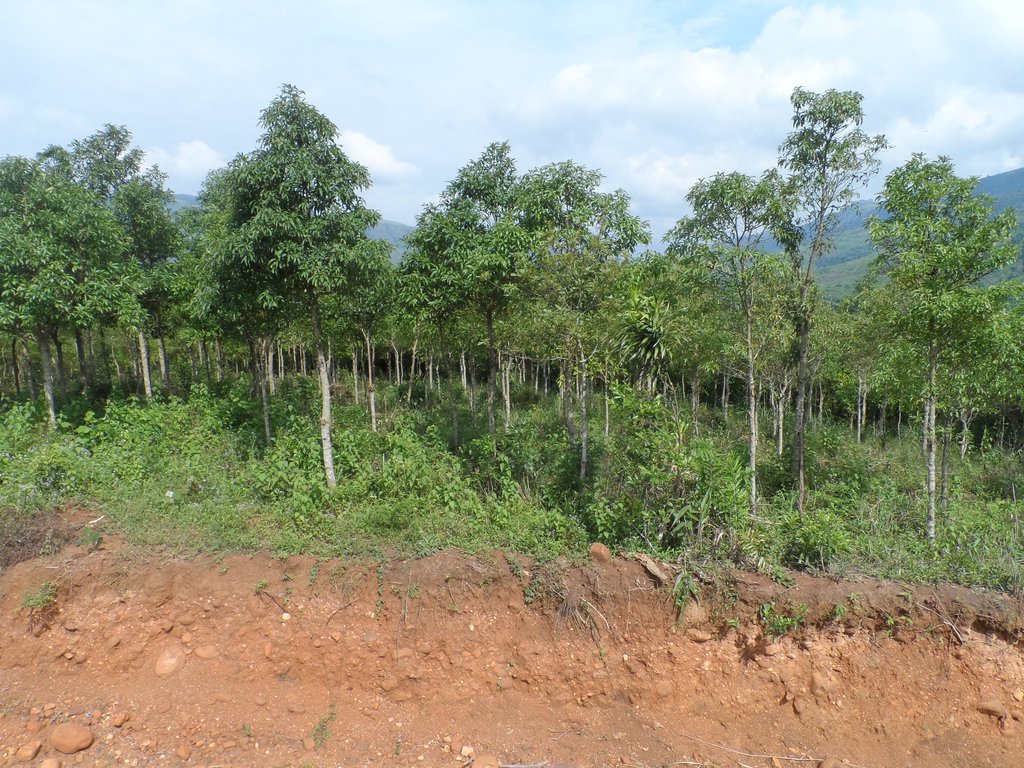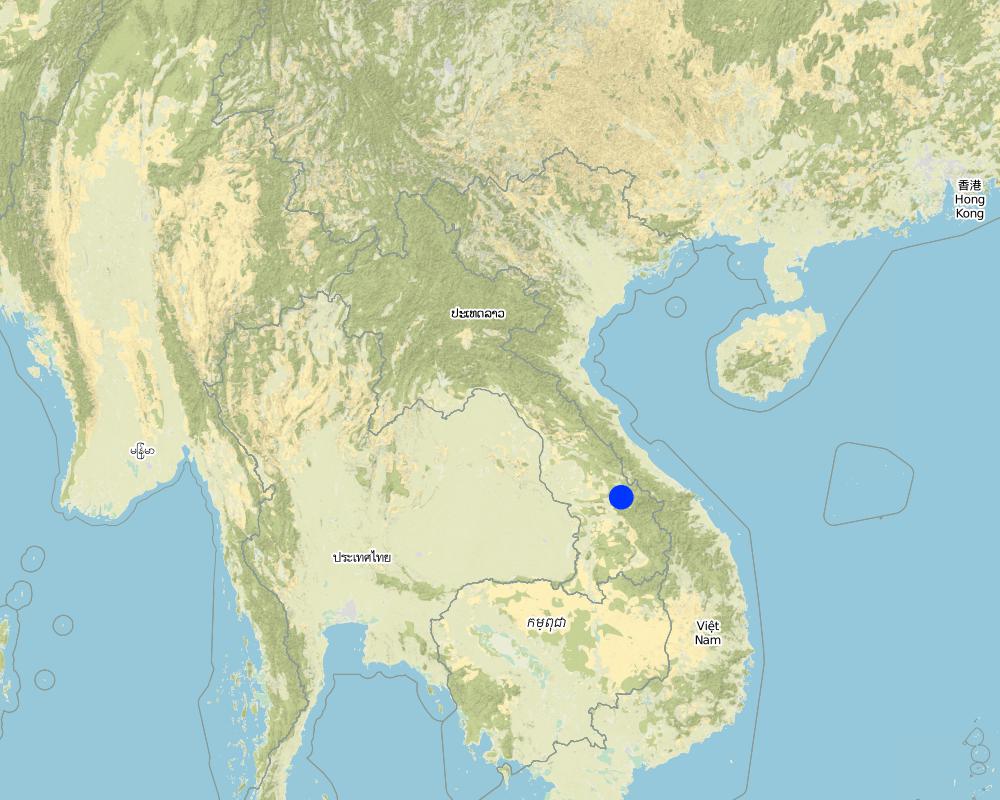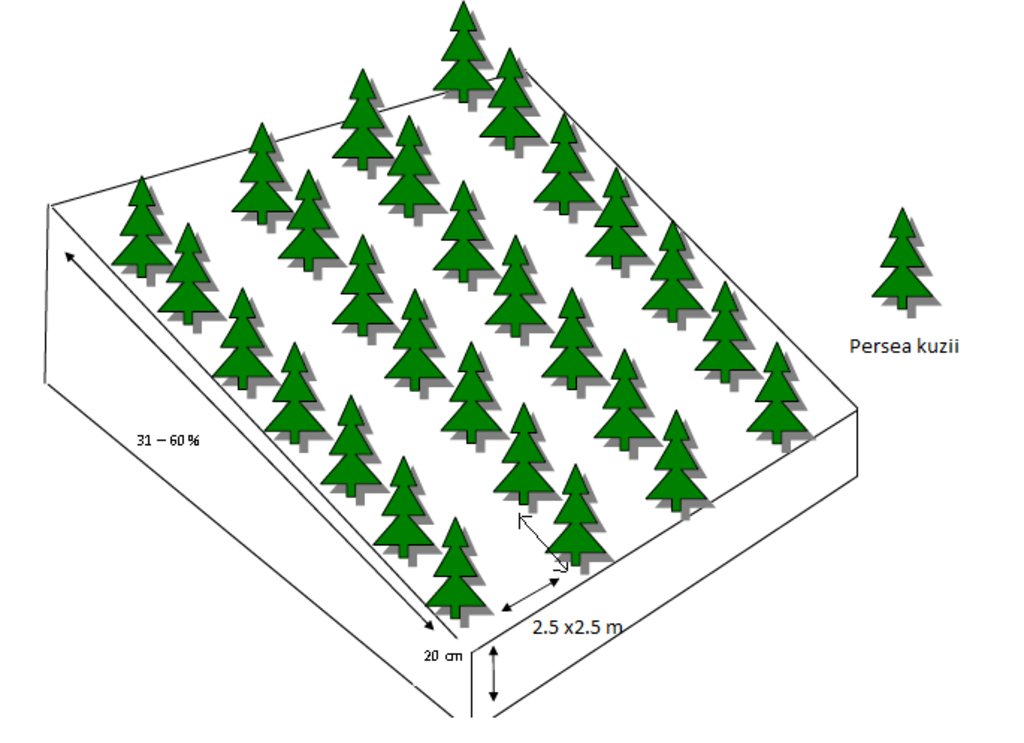ການປູກຢາງໂບງ ປະສົມປະສານ ກັບການລ້ຽງສັດ ໃນພື້ນທີ່ ດິນຄ້ອຍຊັນ [Lao People's Democratic Republic]
- Creation:
- Update:
- Compiler: jimmy luangphithack
- Editors: sackmysay SANIDBOUNMEE, Bounthanom Bouahom, Pasalath Khounsy, kang phanvongsa, anousit namsena
- Reviewers: Nivong Sipaseuth, Nicole Harari, Stephanie Jaquet, Alexandra Gavilano
ການປູກກະແລວແຮງ
technologies_2307 - Lao People's Democratic Republic
View sections
Expand all Collapse all1. General information
1.2 Contact details of resource persons and institutions involved in the assessment and documentation of the Technology
Key resource person(s)
land user:
ສາຍລະວາ ກົນເຕີບ
Lao People's Democratic Republic
Name of project which facilitated the documentation/ evaluation of the Technology (if relevant)
Scaling-up SLM practices by smallholder farmers (IFAD)Name of the institution(s) which facilitated the documentation/ evaluation of the Technology (if relevant)
National Agriculture and Forestry Research Institute (NAFRI) - Lao People's Democratic Republic1.3 Conditions regarding the use of data documented through WOCAT
The compiler and key resource person(s) accept the conditions regarding the use of data documented through WOCAT:
Ja
1.4 Declaration on sustainability of the described Technology
Is the Technology described here problematic with regard to land degradation, so that it cannot be declared a sustainable land management technology?
Nee
2. Description of the SLM Technology
2.1 Short description of the Technology
Definition of the Technology:
ການປູກຢ່າງໂບງໃນເຂດເປີ້ນພູ ເພື່ອເພີ່ມທະວີປ່າໄມ້ ແລະ ນໍາໃຊ້ພື້ນທ່ີປູກ ເພື່ອການລ້ຽງສັດເຊັ່ນ ງົວ ແລະ ສັດປີກ.
2.2 Detailed description of the Technology
Description:
ຢາງໂບງ (Persea kurzii Bong), ເປັນໄມ້ແນວພັນພື້ນເມືອງ ທີ່ມີຕາມທໍາມະຊາດ ເກີດຢູ່ເຂດຕ່າງໆ ໃນ ສປປ ລາວ. ຜ່ານມາຊາວກະສິກອນ ໄປຫາຢາງໂບງທໍາມະຊາດມາຂາຍ ແຕ່ມີປະລິມານຈຳກັດ. ເພ່ືອສືບຕໍ່ສ້າງລາຍຮັບໃຫ້ຊາວກະສິກອນ ຕິດພັນກັບອາຊີບທີ່ເຄີຍເຮັດມາ ການຫັນມາປູກຢາງໂບງ ແມ່ນ ກິດຈະກໍາໜື່ງ ທີ່ເປັນອາຊີບເສີມຂອງຊາວກະສິກອນ. ການປູກຢາງໂບງ ເປັນສວນໄມ້ເສດຖະກິດ ທີ່ໄດ້ບົດຮຽນ ມາຈາກ ພໍ່ຄ້າ ຄົນຫວຽດນາມ (ໃນປີ 2000) ເປັນຜູ້ນໍາມາເຜີຍແຜ່ ໂດຍຜ່ານການທົດລອງປູກ ແລະ ຊາວກະສິກອນ ກໍ່ເຫັນວ່າ ໄດ້ຮັບບົດຮຽນດີ. ໃນປີ2 2006 ຜູ້ນຳໃຊ້ທີ່ດິນ ທີ່ເຄີຍປູກກາເຟ ແລະ ໝາກພິກໄທ ໄດ້ປ່ຽນມາປູກຢາງໂບງ. ຕົກມາເຖີງປີ 2010 ຜູ້ນຳໃຊ້ທີ່ດິນໄດ້ຮັບບົດຮຽນ ການກ້າ ແລະ ປູກຢາງໂບງ ຈາກປະເທດຫວຽດນາມ ໄດ້ລິເລີ່ມກ້າເບ້ຍຢາງໂບງ ແລະ ໄດ້ທົດລອງປູກໃນສວນຕົນເອງ. ຕໍ່ມາກໍ່ມີໂຄງການ International Fund for Agricultural Development (IFAD) ໂດຍຜ່ານ ແຜນງານໂຄງການ ຄ້ຳປະກັນສະບຽງອາຫານ ແລະ ໂພສະນາ ເຊື່ອມໂຍງກັບການຕະຫຼາດ ໄດ້ເຂົ້າມາຊຸກຍູ້ສົ່ງເສີມ ຊາວກະສິກອນ ໃນການປູກຢາງໂບງເປັນສິນຄ້າ.
ຈຸດປະສົງ ເພ່ືອແນໃສ່ ຫຸຼດຜ່ອນການຖາງປ່າເຮັດໄຮ່ ດ້ວຍການສ້າງອາຊີບເສີມ ໃຫ້ຊາວກະສິກອນ ປູກຢາງໂບງ ເປັນສິນຄ້າ, ເພ່ືອສ້າງ ລາຍຮັບໃຫ້ຄອບຄົວ ໂດຍການສະໜອງຝຸ່ນຊີວະພາບ ໃຫ້ຄອບຄົວຕົວແບບ ພ້ອມທັງສະໜອງເຕັກນິກ ໃນການປູກຢາງໂບງ.
ຍ້ອນເຫດຜົນ ແລະ ຂັ້ນຕອນການປະຕິບັດງ່າຍໆ ທີ່ກ່າວມາ ຈ່ືງເຮັດໃຫ້ຊາວກະສິກອນ ສົນໃຈຢາກຫຼາຍຂ້ືນ, ແລະ ຕົ້ນຢາງໂບງ ເປັນຕົ້ນໄມ້ຢືນຕົ້ນ ສາມາດປູກໄດ້ງ່າຍ, ປູກໄດ້ໃນພື້ນທີ່ອາກາດຊຸ່ມຊ່ືນ, ເປັນຕົ້ນໄມ້ທີ່ເຕີບໃຫ່ຍໄວ (ອາຍຸປະມານ 6-7 ປີ ກໍ່ສາມາດກີດ ເອົາເປືອກມາຂາຍໄດ້ ຫຼື ສາມາດ ຕັດເອົາຕົ້ນຢາງໂບງ ໄປຂາຍເປັນສິນຄ້າໄດ້). ຊ່ືງສ້າງລາຍຮັບໃຫ້ຄອບຄົວເປັນໜ້າພໍໃຈ. ປະຈຸບັນເນື້ອທີ່ປູກຢາງໂບງ ຂອງຊາວກະສິກອນ ມີທັງໝົດປະມານ 38 ເຮັກຕາ ຊ່ືງຊາວກະສິກອນ ໄດ້ສືບຕໍ່ຂະຫຍາຍ ເນື້ອທີ່ປູກຢາງໂບງໃນທຸກໆ ປີ (ສະເລ່ຍ 1-2 ເຮັດຕາ/ປີ).
ຊື່ງລາຍລະອຽດເຕັກນິກການປູກຢາງດັາງນີ້: 1) ການກຽມດິນປູກ: ກ່ອນອ່ືນໜົດ ແມ່ນຕ້ອງໄດ້ມີການອານາໄມ້ພ້ືນທີ ໂດຍການເສຍຫຍ້າ ແລ້ວກໍຂຸດຂຸມປູກ ໄປພ້ອມກັນເລີຍ ໃນຊ່ວງຕົ້ນລະດູຝົນ (ເດືອນກໍລະກົດ ເຖີງ ເດືອນ ກັນຍາ), 2) ການວາງໄລຍະປູກ ແລະ ຂຸມປູກ. ໄລຍະຫ່າງລະຫວ່າງຂຸມ/ຕົ້ນ ຢາງ 2.5 × 2.5 m, ຊາວກະສິກອນຕ້ອງວາງຂຸມປູກຢາງ ທົ່ວພື້ນທີ່ ແລະ ຂຸດຂຸມປູກໄວ້. ຂຸດຂຸມປູກເປັນຮູບຈັດຕຸລັດ ມີຄວາມກ້ວາງ ແລະ ເລີກ 25 × 25 cm, ການຂຸດຂຸມ ໂດຍເອົາດິນຊັ້ນໜ້າທີ່ ໄດ້ຈາກການຂຸດຂຸມ
ຂ້ືນມາກອງໄວ້ຢູ່ບໍລິເວນອ້ອມແອ້ມຂຸມກ່ອນ. 3) ການປູກຢ່າງ ແລະ ການໃສ່ຝຸ່ນ: ກ່ອນຈະປູກຢາງໂບງ ນຳໃຊ້ຝຸ່ນຊີວະພາບປົນກັບດິນກົ້ນຂຸມປະມານ 0.5 ກິໂລກຣາມ ຕໍ່ ຂຸມ, ເອົາດິນທີ່ ກອງໄວ້ລົງໜ້ອຍໜື່ງ ຈື່ງວາງເບັ້ຍຢາງລົງ, ເອົາດິນຖົມຂຸມ ແລ້ວ ເອົາມືຂົ່ມດິນລົງ ໃຫ້ເຕັມຂຸມ, ຖ້າເບັ້ຍຕົ້ນຢາງສູງ ອ່ອນ ກໍສາມາດເອົາຫຼັກໄມ້ມາປັກ ແລະ ມັດຄືງຕົ້ນຢາງໄວ້ ບໍ່ໃຫ້ລົ້ມ. 4) ການບົວລະບັດຮັກສາ: ຫຼັງການປູກ 2-3 ເດືອນ ຖ້າສັງເກດເຫັນຕົ້ນຢາງໂບງ ຕົ້ນໃດບໍ່ງາມ ກໍໃສ່ຝຸ່ນຊີວະພາບຕື່ມ, ຫຼື ກໍາຈັດຫຍ້າໄປນໍາ ຄວນໃຊ້ເສດພືດທີ່ຕັດອອກ ປົກຂຸມປູກຢາງ ເພື່ອຮັກສາຄວາມຊຸ່ມຊື່ນຂອງດິນ ພ້ອມດຽວກັນນັ້ນ ເສດພືດທີ່ເນົ່າເປືອຍຢູ່ເທິງໜ້າດິນ ຈະເພີ່ມ ອິນຊີວັດຖຸໃນດິນຕາມທໍາະຊາດຂອງມັນ. ໃນກໍລະນີແຫ້ງແລ້ງ ດິນແໜ້ນ ຕ້ອງຊ່ວຍໃຫ້ນໍ້າ ແກ່ຕົ້ນຢາງ ທັງເປັນການປ້ອງກັນດິນແຕກເຫີບ ຊ່ືງເປັນສາຍເຫດເຮັດໃຫ້ຮາກຢາງຂາດ ແລະ ຕາຍໄດ້.
ຈຸດດີ ສຳລັບເຕັກນິກການປູກຢາງໂບງຢູ່ເຂດຄ້ອຍຊັນ ແມ່ນ ສາມາດສ້າງລາຍຮັບ ທາງກົງຕໍ່ຄອບຄົວຊາວກະສິກອນ ຍັງສາມາດເປັນຮົ່ມ, ໃບຢາງໂບງ ທີ່ຕົກລົງດິນ ສາມາດເພີ່ມອິນຊີວັດຖຸໃນດິນ, ຮັກສາຄວາມຊຸ່ມຊ່ືນຂອງດິນ ດິນອຸດົມ ສົມບູນຂ້ືນ. ກ້ອງຕົ້ນຢາງເກີດມີເຄືອຂີ້ກະເດືອນ ແລະ ຫຍ້າຕ່າງໆ ທີ່ເປັນອາຫານໃຫ້ສັດລ້ຽງໄດ້.
ຕົ້ນຢາງໂບງອາຍຸໄດ້ 3 ປີ ຂື້ນໄປ ຜູ້ນຳໃຊ້ທີ່ດິນກໍ່ສາມາດ ນຳສັດລ້ຽງ ເປັນຕົ້ນແມ່ນງົວ ເຂົ້າປ່ອຍໃນເຂດພື້ນທີ່ດັ່ງກ່າວໄດ້ ແລະ ນອກຈາກນັ້ນ ກໍ່ສາມາດລ້ຽງເປັດ ແລະ ໄກ່ໄດ້ ເພາະເປັດໄກ່ ເພາະເປັດໄກ່ສາມາດເຂົ້າໄປກິນຂີ້ກະເດືອນ ຢູ່ພາຍ ໃນກ້ອງຕົ້ນຢາງໂບງໄດ້ ເຮັດໃຫ້ສັດໃຫຍ່ໄວ ແລະ ມີນ້ຳໜັກດີ.
ຈຸດອ່ອນຂອງການປູກຢາງໂບງ ພາຍຫຼັງທີ່ ຕົ້ນຢາງໂບງໃຫຍ່ ກ່ໍເປັນປ່າຮົກເຮ້ືອ, ອາດຈະມີ ງູມາອາໃສຢູ່, ໂຕຕໍຫຼື ໂຕແຕນ ແລະ ຍູງຫຼາຍ.
2.3 Photos of the Technology
2.5 Country/ region/ locations where the Technology has been applied and which are covered by this assessment
Country:
Lao People's Democratic Republic
Region/ State/ Province:
ແຂວງສາລະວັນ
Further specification of location:
ເມືອງສະໝ້ວຍ
Specify the spread of the Technology:
- evenly spread over an area
If precise area is not known, indicate approximate area covered:
- 0.1-1 km2
Map
×2.6 Date of implementation
Indicate year of implementation:
2010
If precise year is not known, indicate approximate date:
- less than 10 years ago (recently)
2.7 Introduction of the Technology
Specify how the Technology was introduced:
- through projects/ external interventions
3. Classification of the SLM Technology
3.1 Main purpose(s) of the Technology
- reduce, prevent, restore land degradation
- create beneficial economic impact
3.2 Current land use type(s) where the Technology is applied

Forest/ woodlands
- (Semi-)natural forests/ woodlands
- Tree plantation, afforestation
(Semi-)natural forests/ woodlands: Specify management type:
- Shifting cultivation
Tree plantation, afforestation: Specify origin and composition of species:
- Monoculture local variety
Products and services:
- Grazing/ browsing
- ໃຊ້ໃນການປຸກເຮືອນ ແລະ ເຮັດຮົ້ວສວນ
Comments:
ຈໍານວນ ລະດູການ ປູກໃນປີໜຶ່ງ: 1
ຄວາມໜາແໜ້ນ ຂອງສັດລ້ຽງ: ປ່ອຍງົວໃສ່ເນື້ອທີປູກໂບງ 2 ໂຕ/ເຮັກຕາ ມີງົວທັງໝົດ 15 ໂຕ
3.4 Water supply
Water supply for the land on which the Technology is applied:
- rainfed
3.5 SLM group to which the Technology belongs
- agroforestry
- pastoralism and grazing land management
- integrated soil fertility management
3.6 SLM measures comprising the Technology

management measures
- M1: Change of land use type
3.7 Main types of land degradation addressed by the Technology

soil erosion by water
- Wg: gully erosion/ gullying

biological degradation
- Bc: reduction of vegetation cover
- Bq: quantity/ biomass decline
- Bf: detrimental effects of fires
3.8 Prevention, reduction, or restoration of land degradation
Specify the goal of the Technology with regard to land degradation:
- prevent land degradation
- reduce land degradation
4. Technical specifications, implementation activities, inputs, and costs
4.1 Technical drawing of the Technology
Technical specifications (related to technical drawing):
ປະລິມານ ເບ້ຍຢາງໂບງ ປະມານ 1600 ເບ້ຍ/ເຮັກຕາ
ການປູກຢາງໂບງ ແມ່ນປູກໃສ່ພື້ນທີ່ ທີ່ມີຄວາມຄອຍຊັນ ຂອງພື້ນທີ່ປະມານ 16-30 %
ການປູກຢາງໂບງ ຂຸມມີຄວາມເລີກ 20 cm. ກ້ວາງ 25 x 25 cm
ໄລຍະຫ່າງ ຂອງຕົ້ນຢາງໂບງ 2.5 x 2.5 ແມັດ
Author:
ທ້າວ ຈິມມີ້ ຫຼວງພິທັກ
Date:
17/05/2017
4.2 General information regarding the calculation of inputs and costs
Specify how costs and inputs were calculated:
- per Technology area
Indicate size and area unit:
1 ເຮັກຕາ
other/ national currency (specify):
ກີບ
If relevant, indicate exchange rate from USD to local currency (e.g. 1 USD = 79.9 Brazilian Real): 1 USD =:
8000.0
Indicate average wage cost of hired labour per day:
໌50000
4.3 Establishment activities
| Activity | Timing (season) | |
|---|---|---|
| 1. | ການກ້າເບ້ຍຢາງໂບງ | ເດືອນທີ 1-2 |
| 2. | ການຖ່າງປ່າ ແລະ ການຈູດອານາໄມພື້ນທີ່ ກ່ອນປູກຢາງໂບງ ( | ເດືອນທີ 1-2 |
| 3. | ການຂຸດຂຸມ | ເດືອນທີ 7-8 |
| 4. | ໃສ່ຝຸ່ນຊີວະພາບ ຮອງພ້ືນ | ເດືອນທີ 8-9 |
| 5. | ປູກ | ເດືອນທີ 8-9 |
| 6. | ເສຍຫຍ້າ ໃນຊ່ວງ 3 ປີ ທໍາອິດ | ເດືອນ 8-9 ແລະ 1-2 |
| 7. | ເສຍຫຍ້າ ພາຍຫຼັງ ປີທີ 4-6 | ເດືອນ 8-9 |
4.4 Costs and inputs needed for establishment
| Specify input | Unit | Quantity | Costs per Unit | Total costs per input | % of costs borne by land users | |
|---|---|---|---|---|---|---|
| Labour | ແຮງງານຂຸດຂຸມ | ມື້ | 1600.0 | 500.0 | 800000.0 | 100.0 |
| Labour | ແຮງງານປູກ | ມື້ | 1600.0 | 1000.0 | 1600000.0 | 100.0 |
| Labour | ແຮງງານ ໃນການຖາງປ່າ ແລະ ອານາໄມພື້ນທີ່ | ຄົນ | 60.0 | 30000.0 | 1800000.0 | 100.0 |
| Equipment | ພ້າ | ດວງ | 20.0 | 20000.0 | 400000.0 | 100.0 |
| Equipment | ຈົກ | ດວງ | 20.0 | 35000.0 | 700000.0 | 100.0 |
| Equipment | ຊ້ວນ | ດວງ | 20.0 | 35000.0 | 700000.0 | 100.0 |
| Plant material | ເບ້ຍຢາງໂບງ | ເບ້ຍ | 1600.0 | 1000.0 | 1600000.0 | 100.0 |
| Total costs for establishment of the Technology | 7600000.0 | |||||
| Total costs for establishment of the Technology in USD | 950.0 | |||||
Comments:
ຈໍານວນຂຸມ, ການປູກ ແລະ ເບ້ຍເບ້ຍທີ່ກ່າວມາຂ້າງເທິງແມ່ນ 1 ເຮັກຕາ.
ນັ້ນຫມາຍຄວາມວ່າໃນ 38 ເຮັກຕາຊາວກະສິກອນຈະມີ 1600 ຂຸມ x 38 ເຮັກຕາ = 60.800 ຂຸມ, ການປູກ ແລະ ເບ້ຍ
ດັ່ງນັ້ນແຮງງານສໍາລັບການຂຸດຂຸມໃນ 38 ເຮັກຕາແມ່ນ 500 x 60,800 = 30,400,000 ກີບ
ແຮງງານສໍາລັບການປູກຕົ້ນໄມ້ໃນ 38 ເຮັກຕາແມ່ນ 1000 x 60,800 = 60,800,000 ກີບ
ແລະເບ້ຍໄມ້ ຕົ້ນທືນໃນ 38 ເຮັກຕາແມ່ນ 1000 x 60,800 = 60,800,000 ກີບ
4.5 Maintenance/ recurrent activities
| Activity | Timing/ frequency | |
|---|---|---|
| 1. | ການບົວລະບັດຮັກສາ(ຖ່າງຫຍ້າ) | ເດືອນ1 ແລະ ເດືອນ 8 ຂອງທຸກໆປີ |
| 2. | ເກັບກ່ຽວໄມ້ | |
| 3. | ເກັບຕໍໄມ້ |
4.6 Costs and inputs needed for maintenance/ recurrent activities (per year)
| Specify input | Unit | Quantity | Costs per Unit | Total costs per input | % of costs borne by land users | |
|---|---|---|---|---|---|---|
| Labour | ແຮງງານຖາງຫຍ້າ | ຄົນ | 60.0 | 30000.0 | 1800000.0 | 100.0 |
| Labour | ແຮງງານເກັບກ່ຽວໄມ້ | ຄົນ | 100.0 | |||
| Labour | ແຮງງານເກັບຕໍໄມ້ | ຄົນ | 100.0 | |||
| Fertilizers and biocides | ຝຸ່ນຊີວະພາບ | ສອບ/ເຮັກຕາ | 1000.0 | 15000.0 | 15000000.0 | 100.0 |
| Total costs for maintenance of the Technology | 16800000.0 | |||||
| Total costs for maintenance of the Technology in USD | 2100.0 | |||||
4.7 Most important factors affecting the costs
Describe the most determinate factors affecting the costs:
ແຮງງານແມ່ນປັດໃຈສໍາຄັນ ໂດຍສະເພາະ ແມ່ນເ ຂດພື້ນທີ່ທີ່ຕ້ອງການການບໍາລຸງຮັກສາຫຼາຍກວ່າເກົ່າ
5. Natural and human environment
5.1 Climate
Annual rainfall
- < 250 mm
- 251-500 mm
- 501-750 mm
- 751-1,000 mm
- 1,001-1,500 mm
- 1,501-2,000 mm
- 2,001-3,000 mm
- 3,001-4,000 mm
- > 4,000 mm
Agro-climatic zone
- humid
5.2 Topography
Slopes on average:
- flat (0-2%)
- gentle (3-5%)
- moderate (6-10%)
- rolling (11-15%)
- hilly (16-30%)
- steep (31-60%)
- very steep (>60%)
Landforms:
- plateau/plains
- ridges
- mountain slopes
- hill slopes
- footslopes
- valley floors
Altitudinal zone:
- 0-100 m a.s.l.
- 101-500 m a.s.l.
- 501-1,000 m a.s.l.
- 1,001-1,500 m a.s.l.
- 1,501-2,000 m a.s.l.
- 2,001-2,500 m a.s.l.
- 2,501-3,000 m a.s.l.
- 3,001-4,000 m a.s.l.
- > 4,000 m a.s.l.
Indicate if the Technology is specifically applied in:
- not relevant
5.3 Soils
Soil depth on average:
- very shallow (0-20 cm)
- shallow (21-50 cm)
- moderately deep (51-80 cm)
- deep (81-120 cm)
- very deep (> 120 cm)
Soil texture (topsoil):
- medium (loamy, silty)
Soil texture (> 20 cm below surface):
- medium (loamy, silty)
Topsoil organic matter:
- medium (1-3%)
5.4 Water availability and quality
Ground water table:
5-50 m
Availability of surface water:
good
Water quality (untreated):
unusable
Is water salinity a problem?
Nee
Is flooding of the area occurring?
Nee
5.5 Biodiversity
Species diversity:
- medium
Habitat diversity:
- medium
5.6 Characteristics of land users applying the Technology
Sedentary or nomadic:
- Sedentary
Market orientation of production system:
- mixed (subsistence/ commercial)
Off-farm income:
- 10-50% of all income
Relative level of wealth:
- average
Individuals or groups:
- individual/ household
Level of mechanization:
- manual work
- mechanized/ motorized
Gender:
- women
- men
Age of land users:
- middle-aged
- elderly
5.7 Average area of land used by land users applying the Technology
- < 0.5 ha
- 0.5-1 ha
- 1-2 ha
- 2-5 ha
- 5-15 ha
- 15-50 ha
- 50-100 ha
- 100-500 ha
- 500-1,000 ha
- 1,000-10,000 ha
- > 10,000 ha
Is this considered small-, medium- or large-scale (referring to local context)?
- large-scale
5.8 Land ownership, land use rights, and water use rights
Land ownership:
- individual, titled
Land use rights:
- individual
Water use rights:
- open access (unorganized)
5.9 Access to services and infrastructure
health:
- poor
- moderate
- good
education:
- poor
- moderate
- good
technical assistance:
- poor
- moderate
- good
employment (e.g. off-farm):
- poor
- moderate
- good
markets:
- poor
- moderate
- good
energy:
- poor
- moderate
- good
roads and transport:
- poor
- moderate
- good
drinking water and sanitation:
- poor
- moderate
- good
financial services:
- poor
- moderate
- good
6. Impacts and concluding statements
6.1 On-site impacts the Technology has shown
Socio-economic impacts
Production
animal production
Comments/ specify:
ເມີ່ອກ່ອນ ເນື້ອທີ່ການຜະລິດຢູ່ໃນປ່າ ຖືກຈໍາກັດ. ຫຼັງຈາກການຂະຫຍາຍຕົວ ຂອງພື້ນທີ່
ຢາງໂບງ ໂດຍການປູກຕົ້ນໄມ້, ສັດລ້ຽງໄດ້ມີພື້ນທີ່ເຫມາະສົມ ສໍາລັບການລ້ຽງສັດ ແລະ ດັ່ງນັ້ນ, ຜູ້ໃຊ້ທີ່ດິນສາມາດຂະຫຍາຍການສັດລ້ຽງຂອງຕົນ
wood production
Comments/ specify:
ກ່ອນການປູກໄມ້ໄຜ່, ຊາວກະສິກອນໄດ້ເກັບໄມ້ ແລະ ເປືອກຂອງຕົ້ນໂບງ ໃນປ່າທໍາມະຊາດ. ຫລັງຈາກປູກຕົ້ນໂບງ, ລາວສາມາດເພີ່ມການຜະລິດໄມ້ ແລະ ເປືອກເພື່ອ ຈຸດປະສົງໃນການກໍ່ສ້າງ.
Income and costs
workload
Comments/ specify:
ວຽກງານຂອງຜູ້ໃຊ້ທີ່ດິນເພີ່ມຂື້ນຢ່າງຫຼາຍ ເນື່ອງຈາກພື້ນທີ່ຂະຫນາດໃຫຍ່ ຂອງການປູກຢາງບົງ (38 ເຮັກຕາ)
Socio-cultural impacts
conflict mitigation
Comments/ specify:
ເນ່ືອງຈາກວ່າບາງຄົນຕັດຢາງໂບງ ແລະ ລັກໄມ້
Ecological impacts
Soil
soil loss
Comments/ specify:
ໄມ້ໂບງ ມີລະບົບຮາກຂະຫຍາຍຕົວ ທີ່ມີປະສິດທິພາບ ໃນການຜູກມັດດິນ ຢູ່ເທິງເປີ້ນພູ ແລະດັ່ງນັ້ນ ສິ່ງນີ້ຊ່ວຍຫຼຸດຜ່ອນ ແລະ ປ້ອງກັນການເຊາະເຈື່ອນຂອງດິນ.
nutrient cycling/ recharge
Comments/ specify:
ຫຍ້າທີ່ເຕີບໂຕຕາມທໍາມະຊາດໃນພື້ນທີ່ ໄມ້ຢາງໂບງ ສາມາດໃຫ້ສັດລ້ຽງກິນໄດ້. ມູນຂອງສັດທີ່ປະສົມກັບ ໃບຂອງໄມ້ຢາງໂບງ, ເປັນຝຸ່ນທີ່ເຫມາະສົມສໍາລັບຕົ້ນໂບງ (ຕົ້ນໂບງແລະຫຍ້າ).
Climate and disaster risk reduction
fire risk
Comments/ specify:
ຜູ້ນໍາໃຊ້ທີ່ດິນ ໄດ້ຫັນປ່ຽນທີ່ດິນຈາກການຖາງ, ຈູດປ່າແບບເລື່ອນລອຍ ເຊີ່ງເປັນສາເຫດຂອງໄຟໄໝ້ປ່າມາປູກໄມ້ທີ່ຫມັ້ນຄົງ.
6.2 Off-site impacts the Technology has shown
impact of greenhouse gases
Comments/ specify:
ການຫຼຸດຜ່ອນການເຮັດໄຮແບບເລືອນລອຍ, ເພີ້ມພື່ນທີ່ຂອງປ່າໄມ້ ແລະ ເພີ້ມພື້ນທີ່ການເກັບກັກກາກບອນ
6.3 Exposure and sensitivity of the Technology to gradual climate change and climate-related extremes/ disasters (as perceived by land users)
Gradual climate change
Gradual climate change
| Season | increase or decrease | How does the Technology cope with it? | |
|---|---|---|---|
| annual rainfall | increase | moderately |
Climate-related extremes (disasters)
Hydrological disasters
| How does the Technology cope with it? | |
|---|---|
| landslide | moderately |
6.4 Cost-benefit analysis
How do the benefits compare with the establishment costs (from land users’ perspective)?
Short-term returns:
very negative
Long-term returns:
very positive
How do the benefits compare with the maintenance/ recurrent costs (from land users' perspective)?
Short-term returns:
negative
Long-term returns:
positive
6.5 Adoption of the Technology
- 11-50%
Of all those who have adopted the Technology, how many did so spontaneously, i.e. without receiving any material incentives/ payments?
- 11-50%
Comments:
ປະມານ 24 ຄອບຄົວ
6.6 Adaptation
Has the Technology been modified recently to adapt to changing conditions?
Nee
6.7 Strengths/ advantages/ opportunities of the Technology
| Strengths/ advantages/ opportunities in the land user’s view |
|---|
| ຫຼຸດຜ່ອນ ຄວາມເສຍຫາຍ ຈາກໄພທຳມະຊາດ ເປັນຕົ້ນແມ່ນ ບັນຫາໄຟໃໝ້ລາມປ່າ ຈາກການຖາງປ່າ ເຮັດໄຮ່ເລ່ືອນລອຍ |
| ສາມາດ ປ່ອຍສັດລ້ຽງ (ງົວ ແລະ ເປັດໄກ່) ເຂົ້າໄປລ້ຽງ ໃນສວນຢາງໂບງໄດ້ ພາຍຫຼັງ ທີ່ຕົ້ນຢາງໂບງໃຫຍ່ ອາຍຸ ປະມານ 3 ປີຂື້ນໄປ. |
| ການປູກຢາງໂບງ ສາມາດກະຈາຍຊັບພະຍາກອນ ແລະ ສ້າງລາຍຮັບໃຫ້ຄອບຄົວ |
| Strengths/ advantages/ opportunities in the compiler’s or other key resource person’s view |
|---|
| ມ້ຢບງມີລະບົບຮາກຂະຫຍາຍຕົວ ທີ່ມີປະສິດທິພາບໃນການຜູກມັດດິນ ຢູ່ເທິງເປີ້ນພູ ແລະ ມັນຊ່ວຍຫຸຼດຜ່ອນ ແລະ ປ້ອງກັນການເຊາະເຈ່ືອນຂອງດິນ. |
| ມັນຊ່ວຍຫຼຸດຜ່ອນການສູນເສຍດິນຊັ້ນເທິງ ໃນລະດູຝົນແກ່ຍາວ |
6.8 Weaknesses/ disadvantages/ risks of the Technology and ways of overcoming them
| Weaknesses/ disadvantages/ risks in the land user’s view | How can they be overcome? |
|---|---|
| ເນື້ອທີ່ປູກຢາງໂບງ ທີ່ກ້ວາງຫຼາຍ ຊື່ງຍາກ ແກ່ການບົວລະບັດ ຮັກສາ ແລະການຄຸ້ມຄອງ |
7. References and links
7.1 Methods/ sources of information
- field visits, field surveys
1ຄັ້ງ
- interviews with land users
1 ທ່ານ
When were the data compiled (in the field)?
17/05/2017
Links and modules
Expand all Collapse allLinks
No links
Modules
No modules


